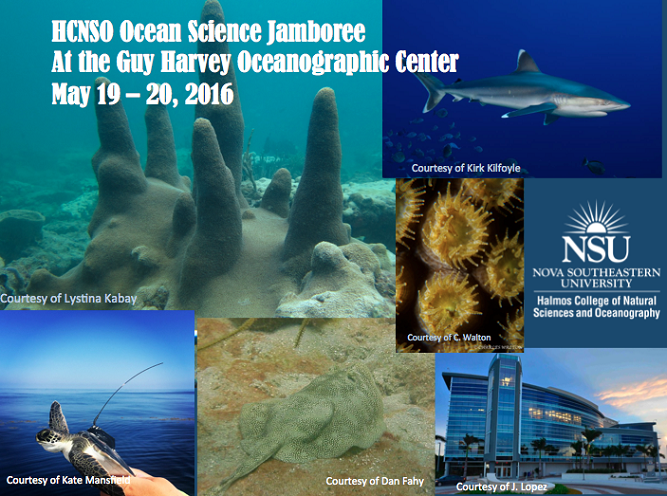Updates of the Global Invertebrate Genome Alliance (GIGA) for Comparative Genomics
Location
Guy Harvey Oceanographic Center Facility
Start
5-20-2016 9:00 AM
End
5-20-2016 9:15 AM
Abstract
This talk will summarize recent progress and activities of the “Global Invertebrate Genome Alliance” (GIGA). This growing community of scientists (COS) formed in 2013 with the ultimate aim to cooperatively sequence or analyse whole genomes and transcriptomes of approximately 7,000 selected invertebrates, with a focus on non-insect, non-nematode marine taxa. A white paper was published in the Journal of Heredity, outlining GIGA’s major goals, its homepage (http://GIGA-cos.org), current data and methodological standards (Journal of Heredity. 2014, vol 105:1-18. http://jhered.oxfordjournals.org/content/105/1/1.full). A second workshop followed in Munich in 2015, which also established a listserver for rapid communication of invertebrate genomics news (https://lists.lrz.de/mailman/listinfo/giga) and began a process of setting up a formal data-sharing portal for marine sequences through http://Compagen.org. The GIGA-COS initiative works with a “bottom up” philosophy, and is timely for several reasons: Invertebrate taxa are underrepresented in the current tally of whole genome projects, comprising no more than 30% of currently completed genomes. The marine realm holds representatives of all but two animal phyla, and many of these are not found in terrestrial or limnic ecosystems. Many invertebrate species are increasingly threatened when residing on fragile habitats (e.g. coral reefs). Sequencing and characterizing more invertebrate genomes provides a valuable and rich data resource, for building better hypotheses. These can eventually lead to better understanding important physiological processes, insight into species resistance and resilience, and the expression of a wide variety of phenotypes – development of diverse body plans and morphology, regenerative capacities, longevity, bioluminescence, secondary metabolites and the evolution of immunity, symbiosis, vision and complex neural networks. Examples to be discussed include the debate on the oldest metazoan (ctenophore or sponge) brought on by new genomics data, and the nearly completed bryozoan genome of Bugula neretina. GIGA and its aspirations clearly address the history of life with genome technology, which will help the GIGA community to grow and exchange ideas relevant to ecological,physiological and conservation contexts.
Updates of the Global Invertebrate Genome Alliance (GIGA) for Comparative Genomics
Guy Harvey Oceanographic Center Facility
This talk will summarize recent progress and activities of the “Global Invertebrate Genome Alliance” (GIGA). This growing community of scientists (COS) formed in 2013 with the ultimate aim to cooperatively sequence or analyse whole genomes and transcriptomes of approximately 7,000 selected invertebrates, with a focus on non-insect, non-nematode marine taxa. A white paper was published in the Journal of Heredity, outlining GIGA’s major goals, its homepage (http://GIGA-cos.org), current data and methodological standards (Journal of Heredity. 2014, vol 105:1-18. http://jhered.oxfordjournals.org/content/105/1/1.full). A second workshop followed in Munich in 2015, which also established a listserver for rapid communication of invertebrate genomics news (https://lists.lrz.de/mailman/listinfo/giga) and began a process of setting up a formal data-sharing portal for marine sequences through http://Compagen.org. The GIGA-COS initiative works with a “bottom up” philosophy, and is timely for several reasons: Invertebrate taxa are underrepresented in the current tally of whole genome projects, comprising no more than 30% of currently completed genomes. The marine realm holds representatives of all but two animal phyla, and many of these are not found in terrestrial or limnic ecosystems. Many invertebrate species are increasingly threatened when residing on fragile habitats (e.g. coral reefs). Sequencing and characterizing more invertebrate genomes provides a valuable and rich data resource, for building better hypotheses. These can eventually lead to better understanding important physiological processes, insight into species resistance and resilience, and the expression of a wide variety of phenotypes – development of diverse body plans and morphology, regenerative capacities, longevity, bioluminescence, secondary metabolites and the evolution of immunity, symbiosis, vision and complex neural networks. Examples to be discussed include the debate on the oldest metazoan (ctenophore or sponge) brought on by new genomics data, and the nearly completed bryozoan genome of Bugula neretina. GIGA and its aspirations clearly address the history of life with genome technology, which will help the GIGA community to grow and exchange ideas relevant to ecological,physiological and conservation contexts.


